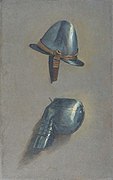
The First Mass in Brazil (Victor Meirelles)
The First Mass in Brazil (Portuguese: Primeira Missa no Brasil) is an oil painting of the historical genre by Brazilian painter Victor Meirelles. It is considered Meirelles' first major work. The painting was created between 1859 and 1861,[1] in Paris, during the period when the artist lived in Europe on a scholarship granted by the Imperial Academy of Fine Arts. Covering an area of 9 m2, The First Mass in Brazil was inspired by the letter written by Pero Vaz de Caminha to the king of Portugal describing the first mass held in the country.[2]
The First Mass in Brazil
1859-1861
270 cm × 357 cm (110 in × 141 in)
Meirelles' painting style is influenced by European aesthetic standards that sought to create heroic figures and exalt nature.[3] The aesthetic nature of the work is related to the moment of affirmation of the Brazilian State and the construction of the country's identity, also in the visual arts.[4]
The painting became one of the most popular and recognized artworks in the country[1] and, exhibited at the Official Salon of Paris in 1861, it was the first Brazilian artwork to participate in a relevant international exhibition. The work also granted Meirelles the title of Imperial Knight of the Order of the Rose and the position of honorary professor at the Academy of Fine Arts.[5]
Analysis[edit]
The First Mass in Brazil is considered by some theorists to be the precursor of historical paintings in Brazil.[7] One characteristic of this genre is verisimilitude, that is, the pretense of reproducing a scene exactly as it happened.[5] In addition to the characteristics of historical paintings, Meirelles was influenced by the painting La première messe en Kabylie by Horace Vernet. The thorough analysis of the French painting, presented at the Salon de Paris in 1855, was motivated by being a reference in which the artist was an eyewitness to the scene: Vernet attended the mass that celebrated the French colonization in North Africa. The French work carried a legitimacy in the parameters of historical painting that inspired the Brazilian painter.[9]
The painting, considered Meirelles' first major work, became one of the most popular artworks in Brazil[1] and is frequently featured in history textbooks.[10] The significance of The First Mass in Brazil was recognized the year after its completion when, in 1861, it was exhibited at the Official Salon of Paris. It was the first time a Brazilian artist participated in an internationally renowned exhibition, marking not only Meirelles' career but also that of the Imperial Academy.
The work and national identity[edit]
Together with other works by Pedro Américo, such as Independence or Death and Batalha do Avaí, and Meirelles' own works, such as Batalha dos Guararapes, The First Mass in Brazil is part of a group of romantic representations of Brazil's history.[11] The theme of the "First Mass" has an extensive iconography in the Americas and was revisited during the Republican period in Brazil as a founding milestone of city creation. It was a way to emphasize regional stories.[2] Meirelles' work aimed to be a founding milestone not only of a specific region but of Brazil as a whole, and its widespread circulation places it as an important element of the collective imaginary of national history.[7]
As a visual representation of an event, the elements that constitute nationality in the artwork have been the subject of academic investigation. The First Mass in Brazil initially suggests that the nation was founded at the moment the Portuguese established Catholicism in the country, a characteristic that contributes to the idea of the nation's emergence from a civilizing action.[7] The harmony among the figures depicted in the painting also suggests an idea of equality and contributes to the creation of another aspect of national identity: that the construction of its symbols is a tool for containing revolts.[4]
Reception[edit]
After its first exhibition at the Salon de Paris in 1861, the artwork was once again exhibited abroad in May 1876. Alongside two other works by Meirelles, Passagem de Humaitá and Combate Naval de Riachuelo, The First Mass in Brazil was displayed in the Fine Arts section of the Philadelphia Exposition in the United States.[8] In addition to its reception in international exhibitions, the artwork granted Victor Meirelles the title of Imperial Knight of the Order of the Rose and the position of honorary professor at the Academy of Fine Arts.[5]
In 2013, the painting was part of the long-term exhibition Quando o Brasil Amanhecia at the National Museum of Fine Arts in Rio de Janeiro,[6] in the Gallery of 19th century Brazilian Art.[12]






